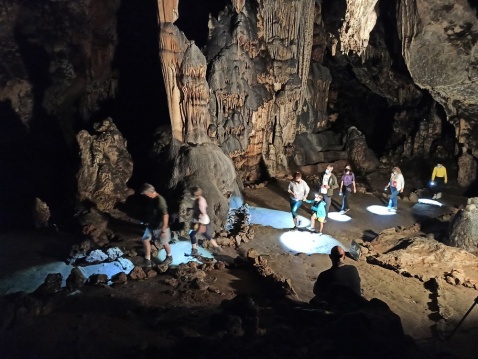
Tour inside Ardales Cave. Photo Ardales Cave |
|
Ardales Cave
Ardales Cave is also known as Cueva de Doña Trinidad or La Calinoria, was discovered in 1821 after the Alhama de Granada earthquake. It opened the cave which had been sealed for more than 8,000 years.
The cave complex situated in the extreme west of the Serrezuela, at about 600 metres altitude above sea level and has a geological age of around 2.5 million years. It has been un-changed for the last 30.000 years. It is a few km east of the village of Ardales.
Doña Trinidad Grund, was daughter of the Consul General in Seville. She moved to Malaga at the age of 15 and she purchased the cave in 1852 to turn it into a tourist attraction. She had a staircase built and fixed supports for torches into the wall. Ardales cave became the first cave tourist attraction in Spain. On her death in 1896 the cave was abandoned.
In 1918 Henri Breuil, the conducted a detailed study. In 1985 when it was opened again to the public. Visitors can enjoy a one and a half kilometre walk through the Gran Sala, la Sala del Lago, la Galería del Espolón, la Galería de los Grabado and la Sala de las Manos.
Stalagmites and stalactites that form curtain-like patterns on the walls appear to have been painted red. These were dated in 2018 to be 65,500 years ago, if correct it makes the oldest cave paintings in the world and by the date atributable to Neanderthal rather than Homo Sapien since modern humans did not reach the Iberian Peninsula until many millennia later. Some scientists have suggested the lines are natural and not human in origin. Paintings in La Pasiega (Cantabria) are also made in a cave by Neanderthals at the same time. There are also some stones with reddish lines that Homo sapiens drew in South Africa 73,000 years ago.
There are also important paintings and engravings dated from the Superior Palaeolithic period of about 20.000 years ago. The most important figure is the Gran Cierva en Negro or the Cierva de Ardales. This is painted in black with a thick red tip where the heart is. There are also drawings of deers, goats, and fish. These paintings are made in 5 different colours. There are more than 80 pictures of deer, horses, goats which make this cave one of the few in the whole world.
The temperature inside the cavity is 16,5º C and the humidity level is stable at 95%. You will need sensible walking shoes. There is some climbing up ladders to see paintings. There is some electric lighting and visitors are given an electric torch.
The visit is three hours in total and you will need reasonable Spanish to get the best out of the tour. The visit is orientated towards those with an interest in Palaeolithic Prehistory of Southern Iberia.
There is a visitor centre about the cave in the village ('Centro de la Prehistoria de Ardales' in the village at Avenida de Málaga nº 1) which is the meeting point for tours. Groups drive in convoy to the cave entrance in their own cars over a rough track, not for anybody who is not confident with mountain driving.
Some of the paintings are accessed by climbing up steps inside the cave. This shouldn't be a problem for anyone with a normal head for heights but those who are particularly sensitive should tell the guide because you can wait at the bottom when the group go up to see the highest parts.
A limited number of visitors a year are allowed to visit this cave, always with an official guide. Visits must be in groups of a maximum of 15 people. It is closed Mondays.
Contact
Tel: 952 458 046 (Tue to Sun 08.30 to 14.30 hrs) or
[email protected]
Admission
Guided tour; Adults 15€ Children (8 to 12 yrs) 5€
Online Reservation (Spanish) for guided tour meeting at 'Centro de la Prehistoria de Ardales' in the village at Avenida de Málaga nº 1. Tours at 10.00, 11.30 and 16.00. Follow guide in own car 3.7km up to cave entrance. Visit takes three hours.
Closed Mondays